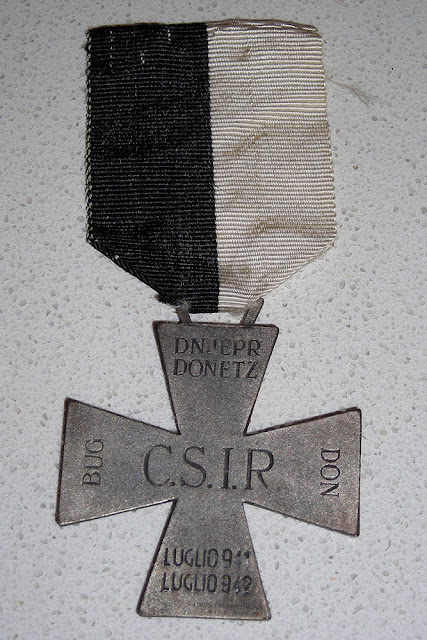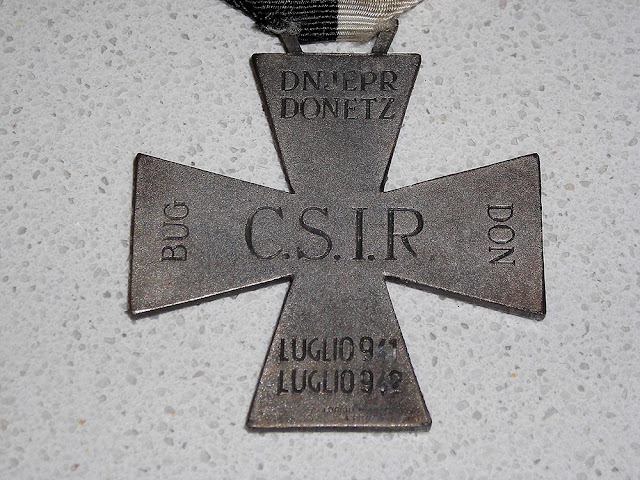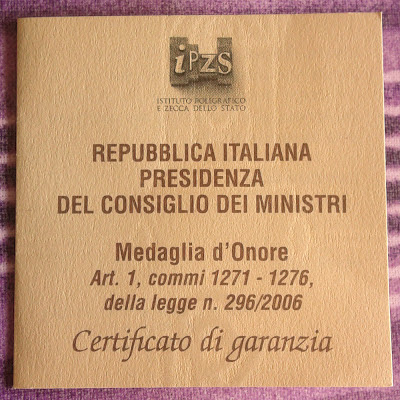Ieri nella festa per il 2 Giugno 2013 ho avuto il piacere di ritirare la medaglia d'onore ai cittadini Italiani deportati e internati nei lager nazisti 1943-1945 concessa a mio nonno, purtroppo mancato nel lontano 1983.
La medaglia è stata istituita con l'articolo 1 commi 1271-1276 della legge n. 296 del 2006.
Mio nonno, Galliano Giorgio, venne catturato in un rastrellamento tedesco assieme ad altri sette ragazzi (Galliano Giovanni, Promis Pierino, Galliano Oreste, Galliano Venanzio, Galliano Epifanio, Galliano Giuseppe, Ferrua Dario) a Roburent il 21 Marzo 1944, probabilmente venne scambiato per un partigiano e poi trasferito in Germania in un campo di lavoro. Purtroppo parlò sempre molto poco di questi periodi della sua vita e mancò troppo presto per potermi raccontare come andarono le cose nello specifico. Le uniche cose certe sono queste riportate anche nel diario di Don Emidio Ferraris parroco di Serra Pamparato all'epoca. Grazie al comune di Pamparato il diario è anche disponibile su internet a questo indirizzo.
http://www.comune.pamparato.cn.it/home/?id_pg=119&id_spg=124
I ricordi di mio padre sono molto vaghi si sa solo che lavorò in una fabbrica e che molte volte patì la fame la loro unica ricchezza era poter mangiare le bucce di patate su un bidone che faceva anche da stufa nella baracca. Quando riuscì a tornare in Italia si dice che si fermarono in una trattoria di paese vicino a Cuneo, la proprietaria, presa da compassione, diede loro da mangiare una gallina bollita di cui non lasciarono nemmeno le ossa.
Oggi, dopo 69 anni, a Cuneo è stata consegnata questa medaglia a 10 persone, 9 alla memoria 1 ad un reduce ancora in vita classe 1922.
(click per ingrandirle)
Yesterday in the festivities for June 2 (REPUBLIC DAY) I had the pleasure to withdraw the medal of honor to the Italian citizens who were deported and interned in Nazi concentration camps from 1943 to 1945 given to my grandfather, unfortunately missed in 1983.
The medal was established by Article 1 of Law No 1271-1276 paragraphs. 296 of 2006.
My grandfather, Giorgio Galliano, was captured in a raid German together with seven other guys (Giovanni Galliano, Promis Pietro, Oreste Galliano, Galliano Venanzio, Epifanio Galliano, Galliano Giuseppe, Ferrua Dario) in Roburent March 21, 1944, was probably mistaken for a partisan and then transferred to a labor camp in Germany. Unfortunately he always spoke very little of these periods of his life and missed too early to be able to tell how things went specifically. The only things certain these are also listed in the diary of Don Emidio Ferraris pastor of Serra Pamparato time. Thanks to the municipality of Pamparato the diary is also available on the Internet at this address.
http://www.comune.pamparato.cn.it/home/?id_pg=119&id_spg=124
The memories of my father are very vague we only know that my grandfather worked in a factory and many times suffered hunger their only wealth was to eat the potato skins on a bin that also served as a heater in the cabin. When he managed to return to Italy it is said that they stopped in the village tavern near Cuneo, the owner, made by compassion, he gave them to eat a boiled chicken which did not leave even the bones.
Today, after 69 years in Cuneo, this medal was handed to 10 people, 9 to memory 1 to a veteran still alive born in 1922.

























